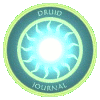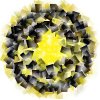In the last post I laid some linguistic groundwork by talking about what word meaning was, and what it wasn’t. In brief, a word is not a clearly defined area of conceptual space, but a set of prototypes: classic, perfect, typical examples of the class. For example, the prototypical house is a a single-family home, free-standing, with one or two stories and maybe a garage and some windows and a lawn. Not all houses are like this, of course, but if something is a lot like this, it’s easy to identify it as a house. Words can have more than one prototype associated with them (such as game), though usually the prototypes of a given word are related and overlapping.
Now we can return and ask: what are the prototypes that make up the meaning of the word pagan?
There is clearly more than one, though they are closely related, and overlapping. Here are some obvious ones:
Druid. The prototypical druid is, of course, a religious and political leader of the ancient Celtic religion, and is associated with the sun, trees, and standing stones. To some extent, all modern druids aspire to this prototype, although there are different ideas about the best way to work toward that aspiration. For example, a Reconstructionist might think it most important to study the ancient druids and replicate as much as possible their practices and beliefs, while a Revivalist might think it most important to reach a modern spiritual understanding of the driving forces behind ancient druid practice.
Witch. The prototypical witch is female, works with herbs, magic, and the moon, is individualist, and holds hidden power. Again, to a great extent, all modern adherents of Wicca aspire to this prototype, although of course male witches need not aspire to be female, and indeed different witches may consider different aspects of the prototype to be central to their practice.
Shaman. The prototypical shaman is particularly associated with the spirit journey, communing with spirits of animals and ancestors, and powers of healing and divination. Shamanistic elements are found in modern druidism and Wicca as well as modern indigenous traditions worldwide, and the New Age subculture.
Indigene. The prototypical indigene — which, it should be emphasized, is different from the real-world indigene — is from a place invaded by Europeans sometime in the last few hundred years; is unfamiliar with the global marketplace and unprepared to compete in it, and therefore is destitute; yet has a rich cultural and spiritual life, passed down for untold generations, that is endangered by the encroachment of Western civilization. This is a caricature, but of course has elements of truth for many individuals around the world whose cultures and languages are indeed endangered, and who are struggling with crippling poverty. But like all prototypes, it is hard to point to a group of people and say, “All, and only, these people are ‘indigenous’.” Nevertheless there are many people who describe themselves as pagan and, strange as it may seem, aspire to this prototype, seeing themselves as guardians of a culture endangered for thousands of years by Christian oppression.
Earth-Centered Religion. The prototype associated with the description Earth-centered is an individual who reveres the Earth, or Nature, as a divine. Most, but certainly not all, pagans today would subscribe to this view — whether it be as actual worshippers of Nature, or contacting and cultivating relationships with Earth spirits, or viewing natural forces as spiritual beings.
Local Religion. The prototype here is of an individual whose spirituality is rooted in the local landscape. Instead of worshipping holy sites halfway round the world, or placing divinity only in the sky or in the spirit realm, the “locally” religious person sees spirit in elements of the local landscape — mountains, fountains, rivers or trees of special import. This is different from the Earth-centered religious prototype (though it often overlaps in an individual), because the Earth-centered religion need not attach particular importance to any one part of the Earth.
Pagan Pluralism

I’m not laying down any laws here, or the findings of a scientific investigation. These are examples drawn from introspection, and I’m sure it would be easy to come up with others, or suggest improvements to my list.
But the point is this: pagan is not a word with a single cut-and-dried meaning; and despite the stakes involved, there is no reason to hammer it down in black and white. At the same time, to shrug our shoulders and say it has no meaning is false and unhelpful.
If battle lines must be drawn, let’s not draw them over the word pagan. What is needed is open acknowledgement that its meaning is made up of multiple overlapping prototypes, and no one can lay claim to them all. Instead of saying “this person is or is not pagan”, we must accept the fuzziness and say, “this person most closely matches prototype X, but has features of prototype Y, and has other features not associated with any particular pagan prototypes”. This is more accurate and honest and doesn’t include or exclude anyone.
Paganism does not need the mantle of “indigenousness” to become a legitimate way of life. “Indigenousness” is an ill-fitting cloak in any case, as a glance at the prototypes will show. At the same time, just because someone doesn’t precisely fit into one of the prototypes does not mean that they are not a true pagan, or a true druid or a true shaman or whatever; none of us are absolutely true to the prototypes, since they are abstract concepts. All of us are aspirants in our own way.
True community is built by trust, and trust is built through honesty and vulnerability. We must be honest enough and vulnerable enough with each other to speak forthrightly about our aspirations and beliefs.
If I want to build community, I do not do it by speaking vaguely about the essential unity of all pagan belief, or by claiming that some other person is less pagan than we are, or by trying to attach myself to some other community.
I build community by admitting that I do aspire to these prototypes — to be a druid, in fact, even though I will clearly never be a political and religious leader of the ancient Celts. By admitting this, I build trust between us, I hope, and thereby strengthen our community, the bond between me and you. You may not agree with me, or hold the same aspirations or beliefs as I do; maybe you even think I’m a bit silly. But perhaps you recognize in me some of the same yearnings and admirations, some of the same reverence for these prototypes that are our inheritance. On this, rather than word-wrangling, is community built.

In the final post in this series, I’ll take up one more thorny question: now that we know what pagan means, is it possible to say definitively whether paganism is a religion?





Leave a comment